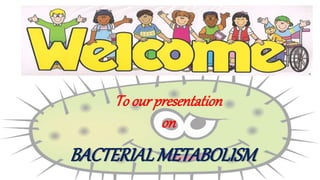
Bacteria Metabolism By Tanzir
- 2. Submitted To, MD. Rafiqul Islam Assistant Professor Dept. of Pharmacy Jessore University Of Science And Technology Submitted by, 1. Most. Nilufar Yeasmin (151036) 2. Chinmoy sen (151038) 3. Md. Jamiul Hassan (151039) 4. Hasan Billah (151040) 5. Nusrat Sarmin Sarna (151041) 6. Tanzir Ahmed (141021) 7. Md. Ahsan Abid (141031) 8. Sumaiya Naznin (141035) Prepared by Tanzir Ahmed
- 3. Microbial Metabolisms • Introduction • Biogenesis • Anabolism • Catabolism • Metabolic Versatility of Organisms • Enzymes • Energy production by aerobic & anaerobic processes • Fermentation process
- 4. Introduction of Microbial Metabolisms • The term metabolism denotes all chemical reactions & physical workings occurring in a cell. • Energy production from metabolism helps a bacterial cell to be extensive and varied. • Energy which produces from metabolism system is required for synthesis of enzymes, nucleic acids, polysaccharides and other chemical components. • Energy is also required for repair damage of cell.
- 5. 2 Types of Metabolism • Anabolism - biosynthesis • building complex molecules from simple ones • requires energy (ATP) • Catabolism - degradation • breaking down complex molecules into simple ones • generates energy (ATP)
- 7. How the organism obtains carbon for synthesizing cell mass • Autotrophic- carbon is obtained from carbon dioxide (CO2) • Heterotrophic-carbon obtained from organic compounds. • Mixotrophic- carbon is obtained from both organic compounds and by fixing carbon dioxide.
- 8. How organism obtains reducing equivalents used in biosynthetic reactions • Lithotrophic- reducing equivalents are obtained from inorganic compounds • Organotrophic-reducing equivalents are obtained from organic compounds
- 9. How the organism obtains energy for living and growing • Chemotrophic-energy is obtained from external chemical compounds • Phototrophic-energy is obtained from light.
- 10. Enzyme • Enzymes are proteins • They have a globular shape • A complex 3-D structure
- 11. What is Enzyme?? • Enzymes are substances present in the cell in minute amounts and capable of speeding up chemical reactions associated with life processes. • Any impairment of enzyme activity is reflected by some change in the cell or even by death. • Different enzymes need for different reaction.
- 13. Types of Enzyme • Simple enzymes – consist of protein alone • Conjugated enzymes or holoenzymes – contain protein and nonprotein molecules • apoenzyme –protein portion • cofactors – nonprotein portion • metallic cofactors – iron, copper, magnesium • coenzymes -organic molecules - vitamins
- 14. Transfer reaction of Enzyme 1. Oxidation-reduction reactions – transfer of electrons 2. Aminotransferases – convert one type of amino acid to another by transferring an amino group 3. Phosphotransferases – transfer phosphate groups, involved in energy transfer 4. Methyltransferases – move methyl groups from one molecule to another 5. Decarboxylases – remove carbon dioxide from organic acids
- 15. Inhibitor • Inhibitors are chemicals that reduce the rate of enzymic reactions. • They are usually specific and they work at low concentrations. • They block the enzyme but they do not usually destroy it. • Many drugs and poisons are inhibitors of enzymes in the nervous system.
- 17. What is Fermentation • Fermentation is a specific type of heterotrophic metabolism that uses organic carbon instead of oxygen as a terminal electron acceptor. • Bacteria produce energy by fermentation. • The lactic fermentation is a typical example: Streptococcus lactis
- 18. Fermentation • Incomplete oxidation of glucose or other carbohydrates in the absence of oxygen • Uses organic compounds as terminal electron acceptors • Yields a small amount of ATP • Production of ethyl alcohol by yeasts acting on glucose • Formation of acid, gas & other products by the action of various bacteria on pyruvic acid
- 19. Fermentation Process Glucose Lactose Mannitol Pyruvic Acid Fermentation Enzymes Lactic acid Ethanol 2,3-Butanediol Mixed Acids
- 20. What is Aerobic processes • It is the normal respiration in plants and animals • In this process Carbohydrates break down • Produce CO2 , water and energy.
- 21. Aerobic process is in four steps • Glycolysis • Formation of Acetyle Co-A • Krebs Cycle • Electron transport system
- 22. Glycolysis • Features of glycolytic pathways • Partial oxidation of glucose to form pyruvic acid • A small amount of ATP is made • A small amount of NAD is reduced to NADH
- 23. Formation of Acetyle Co-A • Each molecule of Pyruvic acid converts into One molecule of Acetyle Co-A • Produces a 2-carbon compound • Yields one molecule CO2 • Produces One molecule of NADH2
- 24. Krebs Cycle • Every molecule of Acetyle Co-A produces 2 molecules of CO2 • 3 molecules of FADH2 • 1 molecule of GTP
- 25. Electron Transport System • NADH2 and FADH2 produced • Being oxidized produce ATP and water
- 26. Anaerobic Process • It does not require any O2 • It occurs in Bacteria • It occurs in two steps • The process is utilized in Lactic Acid fermentation
- 27. Differences Between Aerobic and Anaerobic Characteristics Aerobic Anaerobic Oxygen Require Oxygen Do not require oxygen Pyruvic acid Pyruvic acid oxidized completely Pyruvic acid oxidized incompletely Production of ATP 38 ATP 2 ATP End Products 6 molecules of CO2 and 6 molecules of water 2 molecules of ethanol and 2 molecules of CO2
- 28. For Listening….
- 30. The End